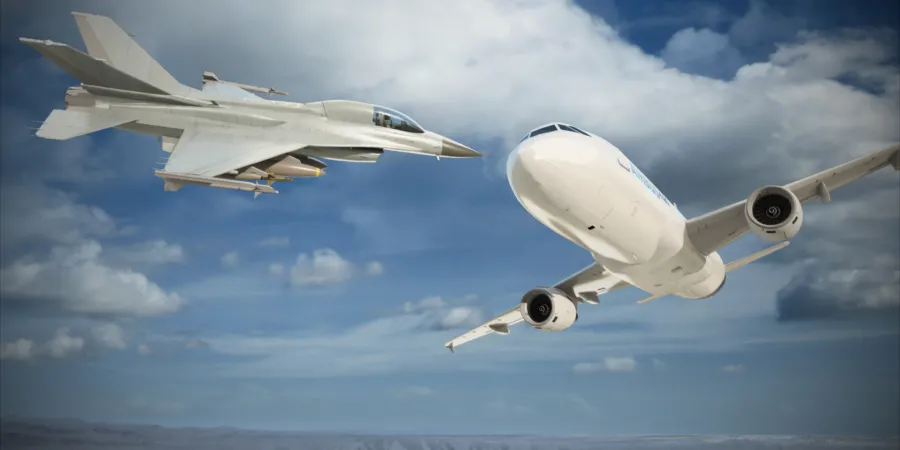IAI Introduces New Collision Warning System
The CWS is the first military system that prevents mid-air collisions with civilian aircraft, improves military flight safety in congested civil airspace
IsraelDefense
| 23/11/2016
Increasing congestion in civil air space poses a growing challenge to flight safety in general and specifically for military operations in proximity to, or within civilian airspace.
Israel Aerospace Industries (IAI) is introducing its Collision Warning System (CWS), designed to warn combat pilots in situations when potential collision with commercial and civilian aircraft is imminent. CWS was developed by IAI’s MALAM Division.
Extending the collision-warning functions of IAI’s EHUD range-independent air-combat maneuvering instrumentation (ACMI), the CWS can now monitor non-military platforms and warn of the proximity and risk of collision with commercial aircraft. Monitoring is performed through integration of IFF (Identification Friend/Foe) and ADS-B (Automatic Dependent Surveillance – Broadcast).
The CWS provides a complete air situational picture with warnings visible only to the military pilot – no indications are provided to civilian aircraft. Warnings are provided in three ways – a voice warning, graphical indication on a tablet panel and symbols presented on existing cockpit displays (MPD/MFD). The CWS is embedded in existing or new EHUD/RAIDS/FRP systems, or carried as a stand-alone pod, which requires only a single interface unit, and thus requires only minimal integration into the aircraft.
The system builds the air situational picture based on the reception and interrogation of EHUD, IFF and ADS-B signals. By plotting existing and projected flight paths of all aircraft flying in the area, the system identifies potential collisions and warns the pilot in advance of such events. Among the data processed are the flight characteristics and maneuverability of each fighter jet, which are profoundly different from those of civilian aircraft. Warnings are therefore generated only when a clear and imminent danger exists.
The CWS is designed for 4th and 5th generation fighter jets, training aircraft, military helicopters and remotely piloted aircraft (RPA). The system is currently in evaluation by a few leading air forces.
“The growing congestion of the airspace and lack of integration between military and civil air spaces require new, independent solutions to prevent collisions. Such systems will improve flight safety without compromising operational freedom,” said Jacob Galifat, General Manager of IAI's MALAM Division. “The CWS combines the independence, operational freedom, ease of integration and affordability which are so important for the military operator, enabling military pilots to fly safely without risk to civilian or military aircraft nearby, in both training and operational flights.”
The CWS is the first military system that prevents mid-air collisions with civilian aircraft, improves military flight safety in congested civil airspace
Increasing congestion in civil air space poses a growing challenge to flight safety in general and specifically for military operations in proximity to, or within civilian airspace.
Israel Aerospace Industries (IAI) is introducing its Collision Warning System (CWS), designed to warn combat pilots in situations when potential collision with commercial and civilian aircraft is imminent. CWS was developed by IAI’s MALAM Division.
Extending the collision-warning functions of IAI’s EHUD range-independent air-combat maneuvering instrumentation (ACMI), the CWS can now monitor non-military platforms and warn of the proximity and risk of collision with commercial aircraft. Monitoring is performed through integration of IFF (Identification Friend/Foe) and ADS-B (Automatic Dependent Surveillance – Broadcast).
The CWS provides a complete air situational picture with warnings visible only to the military pilot – no indications are provided to civilian aircraft. Warnings are provided in three ways – a voice warning, graphical indication on a tablet panel and symbols presented on existing cockpit displays (MPD/MFD). The CWS is embedded in existing or new EHUD/RAIDS/FRP systems, or carried as a stand-alone pod, which requires only a single interface unit, and thus requires only minimal integration into the aircraft.
The system builds the air situational picture based on the reception and interrogation of EHUD, IFF and ADS-B signals. By plotting existing and projected flight paths of all aircraft flying in the area, the system identifies potential collisions and warns the pilot in advance of such events. Among the data processed are the flight characteristics and maneuverability of each fighter jet, which are profoundly different from those of civilian aircraft. Warnings are therefore generated only when a clear and imminent danger exists.
The CWS is designed for 4th and 5th generation fighter jets, training aircraft, military helicopters and remotely piloted aircraft (RPA). The system is currently in evaluation by a few leading air forces.
“The growing congestion of the airspace and lack of integration between military and civil air spaces require new, independent solutions to prevent collisions. Such systems will improve flight safety without compromising operational freedom,” said Jacob Galifat, General Manager of IAI's MALAM Division. “The CWS combines the independence, operational freedom, ease of integration and affordability which are so important for the military operator, enabling military pilots to fly safely without risk to civilian or military aircraft nearby, in both training and operational flights.”



